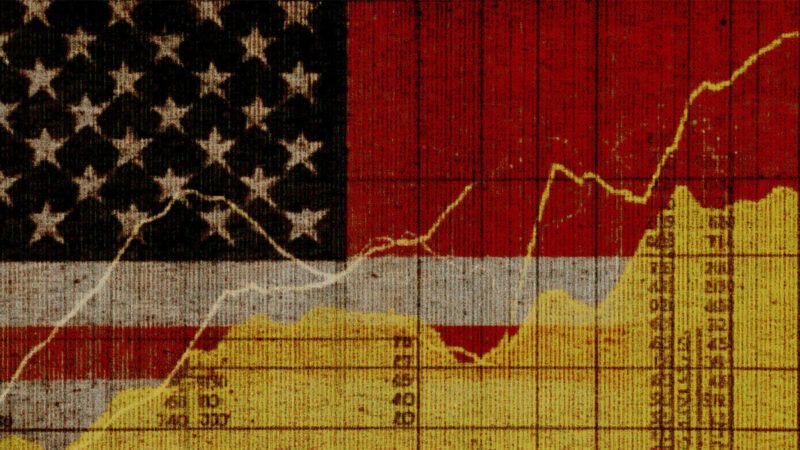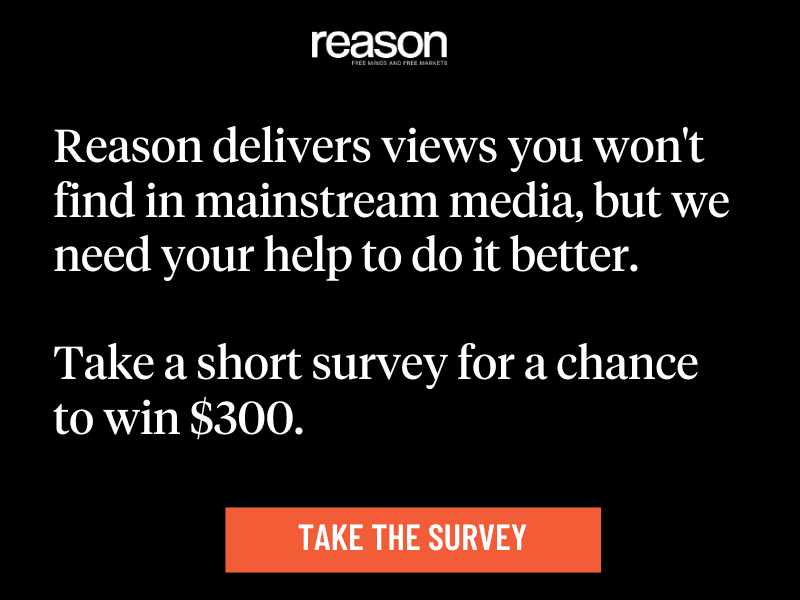The Economy Doesn't Need Federal Jobs Data To Function
There are plenty of private alternatives to the employment report put out by the Bureau of Labor Statistics.

The government shutdown has thus far had no effect on 74 percent of federal spending, but it has led to the furloughing of more than 2,000 of the 2,321 employees working at the Bureau of Labor Statistics (BLS) and delayed the highly anticipated release of its monthly jobs report.
Published on the Friday of each month (except during government shutdowns), the BLS' Employment Situation report details changes in the unemployment and labor force participation rates, the absolute level of total payroll nonfarm employment, and the average hourly wage and weekly hours worked in the previous month. These estimates are produced from monthly surveys of businesses, government agencies, and households administered by the BLS and the Census Bureau.
The delayed release of the BLS report has led to fearmongering about the economy's ability to function. Leila Fadel, host of NPR's Up First, said on Friday that "businesses and policymakers are flying blind" due to the postponed release of the September Employment Situation. In fairness to Fadel, the Joint Economic Committee released a statement that the government shutdown had "impacted the availability of some data used in the [Committee's] Monthly Employment Update," and that it would "incorporate data from the Employment Situation release…into the Monthly Employment Update once the Bureau of Labor Statistics resumes necessary operations."
But even without the BLS report, the economy has not been "flying blind," thanks in part to the myriad private sector sources of labor market data.
On Wednesday, ADP Research, in collaboration with the Stanford Digital Economy Lab, published its monthly National Employment Report (NER) and Pay Insights reports. ADP uses payroll data from more than 500,000 companies and over 26 million employees to provide a monthly measure of U.S. private sector employment and pay scales. The release of both reports found that private sector employment declined by 32,000 workers in September and "year-over-year pay growth for job-stayers was little changed in September at 4.5 percent."
ADP Research's estimates closely track those of the BLS. In August, the agency found that total seasonally adjusted private employment increased by 38,000 jobs while ADP Research that month reported that private employers added 54,000 jobs. Likewise, the July Employment Situation found that the private sector grew by 83,000 that month, while the July NER reported that it grew by 104,000 jobs. The June Employment Situation and June NER, meanwhile, had different results; the BLS reported the private sector grew by 74,000 jobs while ADP Research reported that it shrank by 33,000 jobs. Flash forward to its August Employment Situation, released September 5, and the BLS revised its June estimate of private sector employment to reflect a contraction of 27,000 jobs in June—roughly in line with ADP Research's original estimate of 33,000 private sector jobs lost.
But ADP Research is not the only game in town. For its bimonthly Labor Market Indicators report, the Federal Reserve Bank of Chicago relies on real-time labor market data published by Indeed, Lightcast, Morning Consult, Bloomberg, and Google Trends as well as ADP. The report also uses initial and continuing unemployment insurance claims, which are collected and reported every week by state-level agencies. (The Chicago Fed combines this real-time data with monthly data from the Current Population Survey and Job Openings and Labor Turnover Survey to make its employment forecasts.)
For economists, business executives, and policymakers, it's undoubtedly frustrating that the BLS was unable to publish its monthly employment situation. However, absent a government jobs report, reliable private sector data abound to guide political decision makers and business leaders, proving that the economy can function just fine without bureaucratic number crunchers.
Editor's Note: As of February 29, 2024, commenting privileges on reason.com posts are limited to Reason Plus subscribers. Past commenters are grandfathered in for a temporary period. Subscribe here to preserve your ability to comment. Your Reason Plus subscription also gives you an ad-free version of reason.com, along with full access to the digital edition and archives of Reason magazine. We request that comments be civil and on-topic. We do not moderate or assume any responsibility for comments, which are owned by the readers who post them. Comments do not represent the views of reason.com or Reason Foundation. We reserve the right to delete any comment and ban commenters for any reason at any time. Comments may only be edited within 5 minutes of posting. Report abuses.
Please to post comments




Nope. But during the Bidenflation years, it needed artificially enhanced job numbers to help chaff and redirect away from Biden’s (D) poor performance.
Trust the experts.
Just commenting on the mechanics:
If private data ever replaced BLS statistics for official use, it couldn’t just happen informally — it would require regulation and certification. Federal statistics operate under strict laws for transparency and independence that private datasets don’t yet meet. In addition, new legislation would be needed to reconcile existing statutes such as 5 U.S.C. §§ 5303–5304, which explicitly direct OPM and the President’s Pay Agent to use BLS surveys for federal pay comparisons.
And yes — that “74 percent unaffected” figure comes from mandatory spending and net interest, not operating budgets. Entitlements like Social Security, Medicare, and veterans’ benefits continue automatically, while the discretionary agencies (including BLS) are the ones that actually shut down.
. Federal statistics operate under strict laws for transparency and independence that private datasets don’t yet meet.
Like a revision down of nearly 2M jobs?
I’m not commenting on the issues involved between using a voluntary survey and payroll data from a membership.
Just noting that if a private actor were ever to produce official numbers, then transparency in methodology, privacy protections, retention of vintages, and public access would probably need to be addressed.
However, it is a statist presumption that the manner of addressing those things is legislative. Private statistics producers would have to demonstrate accuracy and reliability or lose customers to better competitors without government interference.
A private actor could do it if the legislation is drafted — I just think oversight isn’t optional once the data carry official weight. Transparency and accountability have to be built in from the start. Control and accountability aren’t the same thing — and when the government is the customer, it gets to define the requirements and level of oversight, because it’s ultimately our money being spent and used for official business.
You keep begging the question requiring official weight. They weight isn't needed. Nothing has to be official. Your problem is your presumption of government approval.
I’m not assuming the data must be official — I’m saying that once government uses them for a public purpose or pays for them, oversight naturally follows. Just about everything enacted into law carries some form of reporting requirement.
Are you suggesting there should be legislation authorizing the use of particular datasets as primary sources, but with no reporting requirements — or only very weak ones? Genuinely curious how that would operate.
Unlike in your fantasy universe, here in the real universe government has power of compulsion that private entities don't. ADP cannot force businesses to comply with its data collection activity.
The public can choose to ignore a public entity who has bad data. Public data right now effects the fed which effects everyone.
See consumer reports.
A few steps short there...
"proving that the economy can function just fine without bureaucratic number crunchers."
The fastest free-est nation the world has ever seen (USA)...
"proves that the economy *functions better* without armed-robbers 'central planning' their next big-hit and calling themselves bureaucrats"
?
The BLS was never for 'the economy'. It exists to provide information for government meddling and to cook numbers to make a President look good.
BLS made Trump look bad, so good riddance. Had they made Trump look good then they would be important and necessary. But they didn't.
2M falsified jobs. Trumps fault!
You really are retarded.
I was not aware that there is only one Friday each month.
One of my instructors in Army AIT had his foot blown off in Vietnam but was still able to teach. Thus proving humans don't need feet.
Dumb.
You lost your brain and here you are. Thanks special Ed.
Accurate economic data is necessary to set proper economic policy. You can't know where a problem is if you don't collect data.
How would explain the deluge of grossly enhanced jobs numbers under the Biden (D) regime?
Where's the enumerated power for ?proper? economic policy?
Or do you really believe the USA was founded on [Na]tional So[zi]alist economics?
I only see a couple gray boxes under your comment, so I don't know what the MAGA responses were. But I heartily agree with you. We need accurate data even when, or especially when, it makes a president look bad.
^"gray box" ignorance - one of many ways we know EdG is a faithful leftard religious-bigot.
Pretty sure 'sarc' brags about the same "gray box" ignorance/bigotry.
All known symptoms of [Na]tional So[zi]alist[s].